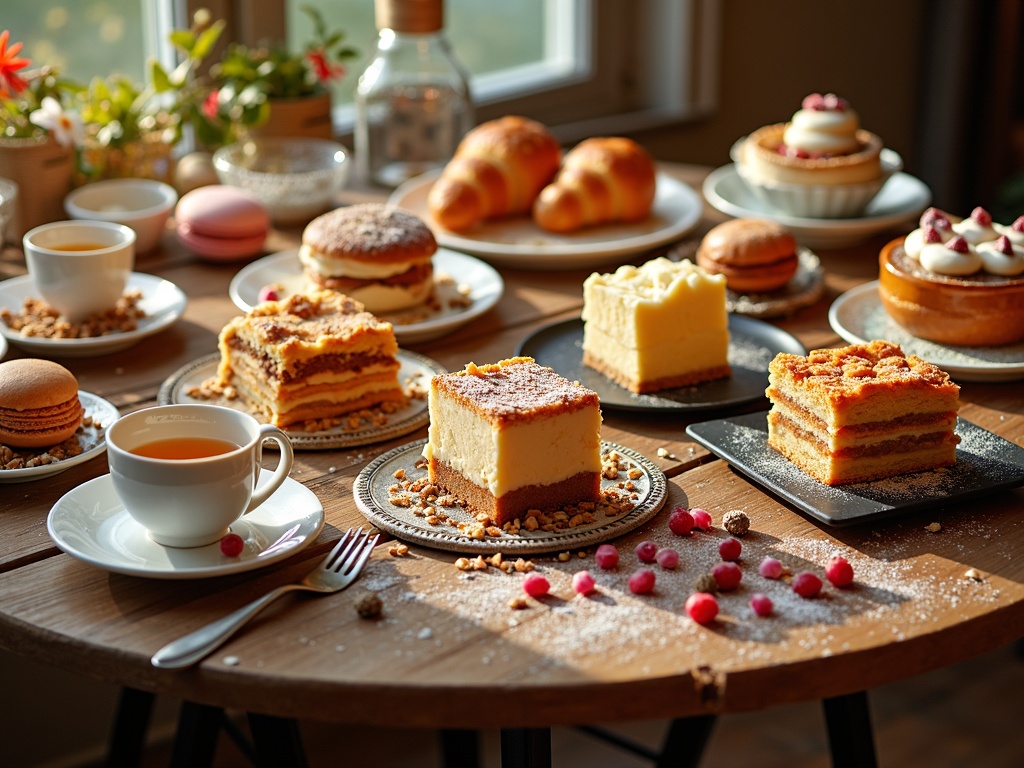From simple indulgences to cultural expressions, desserts offer a window into culinary traditions worldwide while connecting us through shared sweetness. Whether you’re savoring a French macaron or experimenting with fusion creations like mochi donuts, desserts continue to evolve with trends while maintaining their emotional significance across cultures.
Find In This Article
Key Takeaways
- Cultural dessert icons like French pastries, Italian gelato, and Japanese mochi reflect national identities and available ingredients in their regions.
- Global dessert trends include fusion creations, health-conscious alternatives, nostalgic classics with modern updates, and visually striking treats designed for social media.
- Texture has become increasingly important in dessert appreciation, with consumers seeking contrasting elements within single dishes.
- Artisanal, handcrafted desserts command premium prices as consumers increasingly value authenticity and unique flavor profiles.
- Seasonal eating extends to desserts, with limited-time offerings celebrating local harvests at their peak freshness.
The Most Popular Desserts Around the World
Desserts aren’t just sweet endings to a meal; they’re cultural expressions with rich histories spanning generations. I’ve found that dessert preferences vary drastically by region, yet certain treats have captured hearts globally. Whether it’s the simple pleasure of a homemade cookie or the sophisticated layers of a specialty cake, desserts connect us through shared indulgence.
Cultural Dessert Icons That Define Nations
Every country proudly showcases desserts that reflect its unique cultural identity and available ingredients. These signature sweets often become ambassadors for their nations:
- France: The delicate macaron and flaky croissant represent French patisserie excellence
- Italy: Tiramisu and gelato showcase Italian dedication to fresh, quality ingredients
- Japan: Mochi and dorayaki highlight the Japanese appreciation for subtle sweetness
- India: Gulab jamun and jalebi demonstrate the country’s love for aromatic spices and syrup-soaked treats
- Mexico: Churros and tres leches cake reflect influences from both native and colonial histories
My personal favorite has to be a well-made sticky toffee pudding from Britain – the perfect balance of moist date cake and rich toffee sauce creates an irresistible comfort dessert.
Middle Eastern desserts like baklava feature unique combinations of nuts, honey, and delicate phyllo pastry that have remained popular for centuries. Meanwhile, in North America, apple pie has become so culturally significant it’s linked with national identity in the United States.
Global Dessert Trends Reshaping Sweet Traditions
I’ve noticed several fascinating trends transforming dessert scenes worldwide:
- Fusion desserts are gaining tremendous popularity, with creations like mochi donuts and Biscoff cheesecake blending culinary traditions. These hybrid treats appeal to adventurous eaters looking for familiar flavors with unexpected twists.
- Health-conscious desserts have also surged forward, with alternatives that cater to dietary restrictions without sacrificing taste. Plant-based ice creams, gluten-free crinkle cookies, and reduced-sugar confections have become mainstream rather than specialty items.
- Nostalgic desserts are making strong comebacks, often with modern updates. Classic rhubarb crumble might now feature cardamom or ginger alongside the traditional cinnamon, while still evoking childhood memories.
- Social media has dramatically influenced dessert popularity, with visually striking creations designed specifically for Instagram and TikTok. Think mirror-glazed cakes, cookie decorating videos, and elaborate hot cocoa bombs that explode in warm milk.
- Texture has become increasingly important in dessert appreciation, with consumers seeking contrasting elements within single dishes. This explains the popularity of creations like crème brûlée (soft custard under a crackable caramelized sugar top) and chia pudding (smooth base with pleasantly popping seeds).
- Miniature desserts have found their niche as people seek portion control without sacrifice. Petit fours, mini tarts, and bite-sized brownies deliver full flavor experiences in controlled servings.
- Artisanal and handcrafted desserts command premium prices as consumers increasingly value authenticity and craftsmanship. Small-batch ice creams, bean-to-bar chocolates, and sourdough-based pastries attract those willing to pay more for quality and unique flavor profiles.
- Seasonal eating has extended to desserts, with consumers embracing limited-time offerings that celebrate local harvests. This farm-to-table approach for desserts highlights ingredients at their peak, whether it’s summer berries or fall apples.
I’ve found that regardless of changing trends, the emotional connection to desserts remains constant across cultures. They mark celebrations, comfort us during difficult times, and often carry treasured family histories through carefully preserved recipes.
Essential Baking Tools For Success
I’ve found that having the right tools makes all the difference when creating delicious desserts. Whether you’re whipping up chocolate crinkle cookies or preparing a decadent sticky toffee pudding, these essential items will set you up for success.
Must-Have Equipment and Measuring Tools
Precise measurement is the foundation of good baking. Unlike cooking where you can often eyeball ingredients, baking requires accuracy for consistent results.
Here are the basic measuring tools you’ll need:
- Digital kitchen scale: Weighing ingredients (especially flour) provides much more consistent results than volume measurements
- Measuring cups for dry ingredients: Look for durable sets with clear markings
- Liquid measuring cups: Glass or clear plastic cups with spout and measurement lines
- Measuring spoons: For smaller amounts of ingredients like vanilla extract, salt, or leavening agents
- Thermometer: Essential for checking doneness of custards or candy making
Beyond measuring, you’ll need basic tools like mixing bowls (in various sizes), silicone spatulas, whisks, and a cooling rack. A pastry brush is handy for applying egg washes or glazes to your Biscoff cheesecake or other baked goods.
Time-Saving Appliances and Specialty Pans
While not absolutely necessary, certain appliances can transform your baking experience. A stand mixer tops my list – it frees your hands and provides consistent mixing power. For smaller jobs, an electric hand mixer works perfectly.
A food processor makes quick work of crushing graham crackers for pie crusts or blending ingredients for a rhubarb crumble. If you enjoy making hot cocoa or tempering chocolate, an immersion blender helps create smooth consistency.
For pans and molds, I recommend starting with these versatile options:
- 9-inch round cake pans (two for layer cakes)
- 8×8-inch square baking pan for brownies and bar cookies
- Loaf pan for quick breads and pound cakes
- Muffin tin for cupcakes and chia pudding cups
- Rimmed baking sheets for cookies
- Pie plate for sweet and savory pies
Non-stick pans save frustration, but I’ve found that parchment paper is still your best friend for easy removal and cleanup. Silicone baking mats are another fantastic investment that reduce waste and provide excellent non-stick properties.
With these essential tools in your kitchen, you’ll be ready to tackle both simple treats and more ambitious dessert projects with confidence.
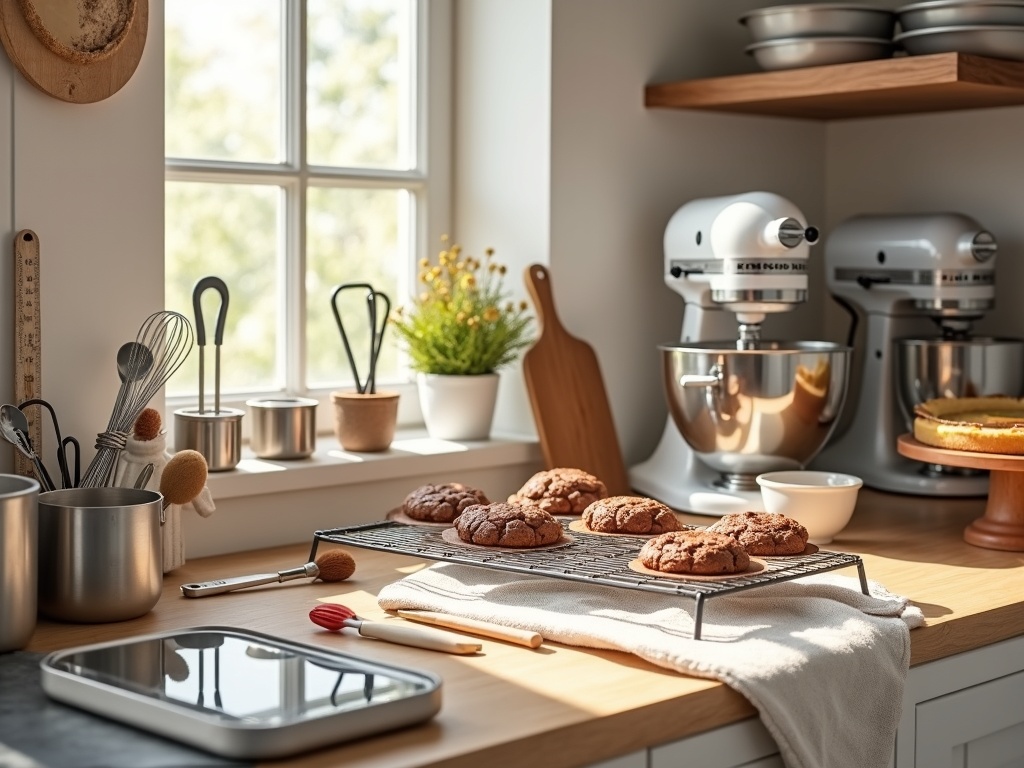
Basic Ingredients Every Baker Needs
Setting up your baking pantry doesn’t have to be complicated. I’ve found that starting with quality staples makes all the difference when creating delicious homemade cookies and treats. Let’s break down the essential ingredients you’ll want to keep on hand.
Flour, Sweeteners, and Leaveners
All-purpose flour serves as the foundation for most baking projects, but expanding your flour collection can elevate your desserts:
- All-purpose flour: The versatile workhorse for most recipes
- Cake flour: Creates tender textures in delicate cakes and pastries
- Bread flour: Higher protein content for chewier treats like bagels
- Whole wheat flour: Adds nutty flavor and nutrition to baked goods
- Almond flour: Perfect for gluten-free baking or rich fruit crumbles
Sweeteners bring flavor beyond just sweetness. While granulated sugar is standard, these alternatives offer unique qualities:
- Brown sugar: Adds moisture and caramel notes to sticky desserts
- Powdered sugar: Dissolves easily for smooth frostings and glazes
- Honey: Provides floral sweetness and helps retain moisture
- Maple syrup: Adds distinctive flavor to breakfast bakes
- Coconut sugar: Offers caramel-like flavor with lower glycemic impact
Leavening agents create the rise needed in baked goods:
- Baking powder: Contains acid and base that react when wet
- Baking soda: Needs acidic ingredients like buttermilk to activate
- Yeast: Living organism that produces carbon dioxide for bread
Dairy Products and Flavor Enhancers
Dairy ingredients contribute moisture, richness, and structure to desserts:
Butter forms the backbone of many recipes, creating flaky textures in pastries and adding richness to creamy cheesecakes. I always recommend unsalted butter so you can control the salt content precisely.
Eggs bind ingredients while adding structure and richness. They’re crucial for everything from cakes to custards for pudding recipes.
Milk products add moisture and tenderness—regular milk works for most recipes, while buttermilk adds tanginess and activates leavening agents. Heavy cream creates luxurious textures in ganaches and hot chocolate drinks.
Flavor extracts can transform basic ingredients into something special:
- Vanilla extract: The universal baking enhancer
- Almond extract: Adds depth to cherry and chocolate desserts
- Lemon extract: Brightens fruit desserts
- Mint extract: Perfect for holiday treats
- Coconut extract: Adds tropical notes without texture changes
Starting with these foundational ingredients opens up countless possibilities in your baking adventures. The quality matters—fresher ingredients produce better results, so I suggest dating your containers and replacing items like baking powder yearly.
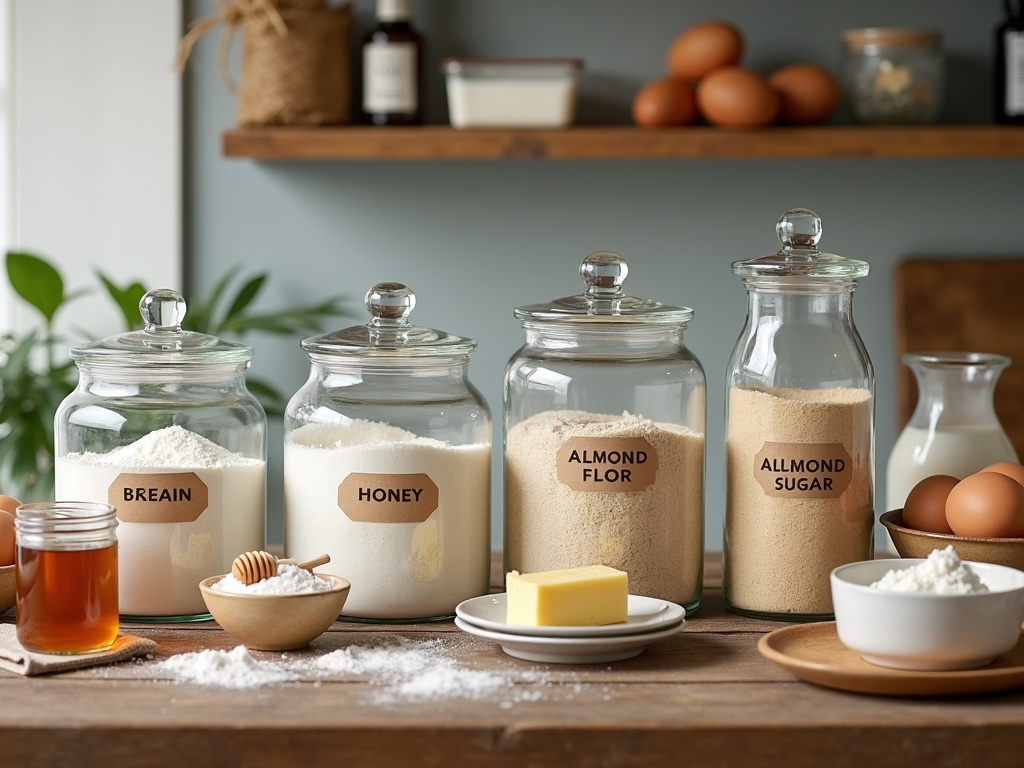
Simple Desserts For Beginners
Starting out in the dessert world doesn’t have to be intimidating. I’ve found that beginners can create impressive sweet treats with minimal effort and ingredients. The key is knowing which recipes provide the most reward for the least amount of skill required.
No-Fuss Sweet Treats Anyone Can Make
No-bake desserts are perfect for novice bakers since they eliminate the anxiety of oven temperatures and baking times. A Biscoff cheesecake is a prime example—it requires just mixing, assembling, and chilling. Similarly, chia pudding offers a nutritious option that simply needs mixing and refrigeration overnight.
Five-ingredient recipes cut down on shopping stress and measurement confusion. Here are some standout options:
- Classic crinkle cookies can be made with cake mix, oil, eggs, powdered sugar, and vanilla
- Simple hot cocoa requires just milk, chocolate, sugar, vanilla, and a pinch of salt
- Basic fruit crumbles like rhubarb crumble need only fruit, sugar, flour, butter, and oats
Quick preparation methods make dessert-making accessible even on busy days. Many delicious treats can be ready in under 30 minutes. For instance, no-churn ice cream bases take just minutes to whip together before freezing. Mug cakes offer nearly instant gratification, cooking in the microwave for less than two minutes.
Fool-proof techniques help ensure success for beginners. I’ve found that one-bowl mixing methods eliminate complicated steps and reduce the chance of errors. Another helpful approach is using ready-made ingredients as shortcuts—store-bought pie crusts or cookie bases can transform into amazing sticky toffee pudding with minimal effort.
The beauty of simple desserts lies in their forgiveness. Unlike complex pastries where precision is critical, these beginner recipes typically have room for small measuring errors or substitutions. This flexibility allows new bakers to build confidence while still creating something delicious.
My advice? Start with something no-bake, move to simple cookies or mug cakes, then gradually challenge yourself with slightly more involved recipes as your confidence grows. Before long, you’ll develop an intuitive feel for dessert-making that extends beyond following recipes.
Common Baking Mistakes To Avoid
Creating delicious desserts requires attention to detail, and even small mistakes can affect your final results. I’ve learned through many trial-and-error experiences that avoiding common pitfalls can transform your baking from disappointing to delightful.
Recipe-Ruining Errors
Incorrect measurements top the list of baking blunders. When a recipe calls for a cup of flour, using a regular drinking cup instead of a measuring cup can lead to dense, dry chocolate crinkle cookies or fallen cakes. I always use proper measuring tools—cups for dry ingredients and clear liquid measuring cups for wet ingredients.
Wrong temperature settings can sabotage your desserts before they even enter the oven. Preheating is crucial! Placing your sticky toffee pudding in a cold oven means it won’t rise properly. Similarly, oven temperatures vary, so an oven thermometer helps ensure you’re baking at the correct heat.
Overmixing batters is a subtle mistake with significant consequences. When making Biscoff cheesecake or cake batters, I stop mixing as soon as ingredients are combined. Overmixing develops gluten, creating tough, rubbery textures rather than tender crumbs.
Substitution errors happen when we get creative without understanding ingredient functions. While making hot cocoa might allow for milk alternatives, baking chemistry is less forgiving. Swapping baking powder for baking soda can leave your rhubarb crumble tasting metallic and flat.
Not following recipe timing instructions can ruin hours of work. I’ve learned to respect baking times—opening the oven door too often lowers temperature and disrupts rising. For recipes like chia pudding that require chilling, cutting short the setting time results in runny desserts instead of perfectly set treats.
Here are key mistakes to avoid in your baking adventures:
- Using volume instead of weight measurements (especially for flour and sugar)
- Opening the oven door during critical rising periods
- Skipping the step of bringing refrigerated ingredients to room temperature
- Using inactive or expired leavening agents
- Ignoring resting or cooling instructions before serving
Baking success comes from understanding that each step serves a purpose. When a recipe says “cream butter and sugar until light and fluffy,” that specific texture creates the foundation for your dessert’s structure. Shortcuts might save time, but they rarely save the final product.
Storage And Preservation
Proper storage can make the difference between desserts that stay fresh for days and ones that become stale overnight. I’ve found that a few simple techniques can extend the life of your sweet creations, saving you time and reducing waste.
Choosing the Right Containers
The container you select plays a critical role in maintaining dessert freshness. For cookies, airtight containers with tight-fitting lids work best to prevent air from making them soft or stale. I place chocolate crinkle cookies in metal tins with parchment paper between layers to maintain their perfect texture.
For cakes and pies, consider these container options:
- Glass containers with locking lids protect delicate frostings while providing visibility
- Cake carriers with adjustable heights accommodate tall layer cakes
- Pie keepers with ventilation options help fruit pies maintain their crisp crusts
Moisture-rich desserts like sticky toffee pudding benefit from containers with slight ventilation to prevent condensation from making them soggy. For cheesecakes, including Biscoff cheesecake, spring-form pan bases can double as storage platforms when covered with plastic wrap or foil.
Temperature and Shelf Life Guidelines
Temperature dramatically affects how long your desserts stay fresh. Room temperature storage works for most cookies, unfrosted cakes, and bread-based desserts, but only for 2–3 days. I’ve found that storing hot cocoa mix ingredients in a cool, dry pantry extends shelf life to several months.
Refrigeration extends shelf life but can affect texture and flavor. For optimal results:
- Cold desserts like chia pudding must be refrigerated and typically last 4-5 days
- Cream-filled or dairy-based desserts should be refrigerated immediately and consumed within 3–4 days
- Fruit-based treats like rhubarb crumble can be refrigerated for up to 5 days, though the topping may soften
When refrigerating cakes, I let them come to room temperature before serving to restore optimal flavor and texture. This takes about 30–60 minutes depending on size.
For freezing desserts, proper preparation prevents freezer burn and texture degradation. Most cookies freeze beautifully for 2–3 months when placed in freezer bags with air removed. I layer them between parchment or wax paper to prevent sticking.
Cakes can be frozen frosted or unfrosted:
- Unfrosted cakes: Wrap tightly in plastic wrap, then foil
- Frosted cakes: Freeze uncovered until firm, then wrap carefully
- Individual slices: Wrap each piece separately for quick defrosting
When freezing fruit pies, I underbake them slightly, as the crust will continue cooking during reheating. This prevents overbrowning while ensuring a fully cooked result.
The defrosting process is just as important as freezing. I always defrost desserts in the refrigerator rather than at room temperature to prevent condensation from making them soggy. For cookies and brownies, a quick 10–15 second microwave burst after thawing can restore that fresh-baked texture.
For cream-based desserts, freezing can sometimes cause separation or texture changes. If you must freeze these items, expect some quality loss upon thawing.
By matching the right storage method to each dessert type, you’ll maximize freshness and minimize waste. Whether you’re preparing treats in advance for a party or saving leftovers for later enjoyment, these storage guidelines will help ensure your sweet creations remain as delicious as the day they were made.
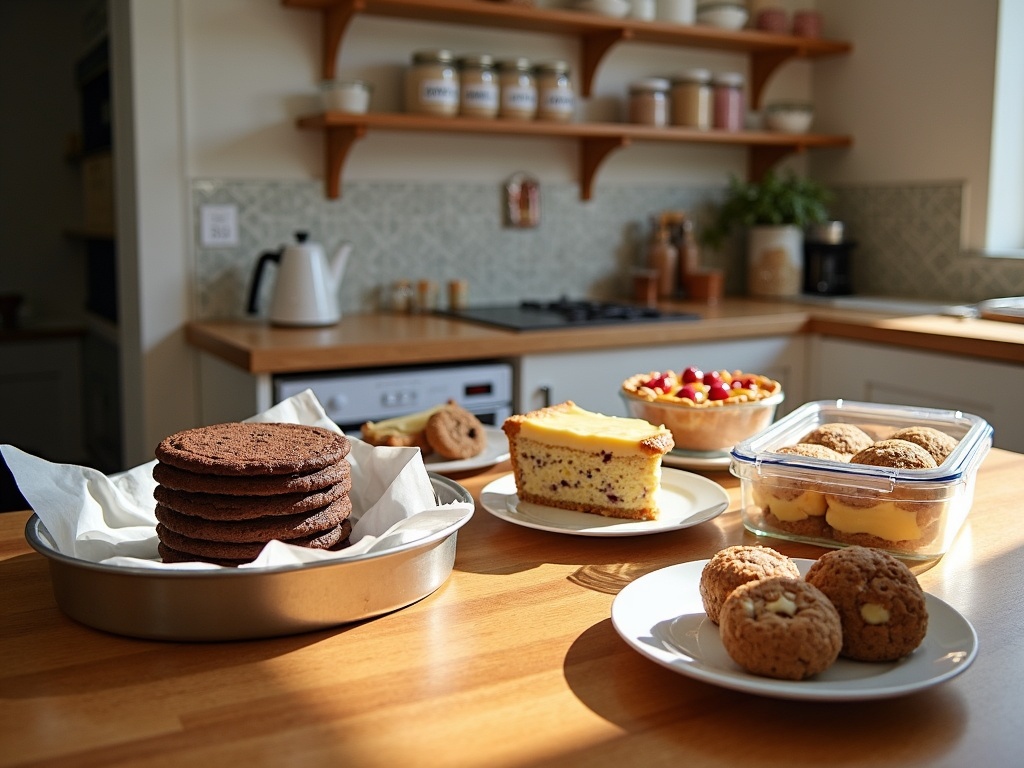
Special Dietary Considerations
Accommodating special dietary needs doesn’t mean sacrificing taste when it comes to desserts. I’ve discovered that with the right substitutions and modifications, desserts can be just as delicious while meeting specific dietary requirements. Whether you’re avoiding gluten, animal products, sugar, or common allergens, there are plenty of ways to adapt classic recipes.
Adapting Recipes for Dietary Needs
Gluten-free baking has come a long way, with many excellent flour alternatives now available. For cookies like chocolate crinkle cookies, I’ve had great results using a blend of rice flour, tapioca starch, and potato starch. This combination provides structure and mimics the texture of wheat flour. Almond flour and coconut flour are other excellent gluten-free options, though they typically require adjusting liquid ratios in recipes.
Vegan baking often seems challenging at first, but I’ve found several reliable substitutions:
- For eggs: Flaxseed or chia “eggs” (1 tablespoon ground seeds mixed with 3 tablespoons of water) work well in most recipes, including a vegan rhubarb crumble
- For butter: Coconut oil, vegan butter, or even mashed banana can replace dairy butter
- For milk: Almond, oat, soy, or coconut milk substitute dairy in equal measurements
- For cream: Coconut cream makes an excellent replacement in recipes like Biscoff cheesecake
Sugar-free desserts have improved dramatically with better alternative sweeteners. Monk fruit and erythritol blend well into recipes without the aftertaste some sweeteners leave. Stevia can work in smaller amounts, while date paste or mashed banana add natural sweetness to treats like chia seed pudding. When adapting recipes, I start with about 1/3 less alternative sweetener than the sugar called for, then adjust to taste.
Allergy-friendly modifications often require creativity. Nut allergies can be accommodated by using seeds instead – sunflower seed butter replaces peanut butter nicely in cookies. For dairy allergies beyond vegan options, coconut milk creates a rich base for hot cocoa or sticky toffee pudding. Soy allergies can be avoided by choosing other plant milks like oat or rice milk.
Texture is often the biggest challenge when making dietary substitutions. I’ve found that adding a bit of xanthan gum (about 1/4 teaspoon per cup of gluten-free flour) helps bind ingredients together. For vegan recipes, aquafaba (the liquid from canned chickpeas) can create the same frothy texture as whipped egg whites in mousses and meringues.
Many desserts naturally fit multiple dietary needs. Fruit sorbets are typically vegan, gluten-free, and can be made without added sugar. Dark chocolate (70% or higher) is often naturally gluten-free and can be dairy-free as well – perfect for dipping strawberries or making chocolate bark with seeds and dried fruit.
When making substitutions, I focus on maintaining the core flavors that make the dessert special. For example, the warm spices in sticky toffee pudding remain important even when adapting the recipe to be gluten-free. The buttery flavor in shortbread cookies can be preserved using vegan butter with a touch of coconut oil.
The key to successful dietary adaptations is patience and experimentation. Not every substitution works perfectly the first time, but with practice, you’ll develop a feel for how alternative ingredients behave. Start with recipes that naturally meet your dietary needs rather than trying to adapt complex recipes that rely heavily on the ingredients you’re avoiding.
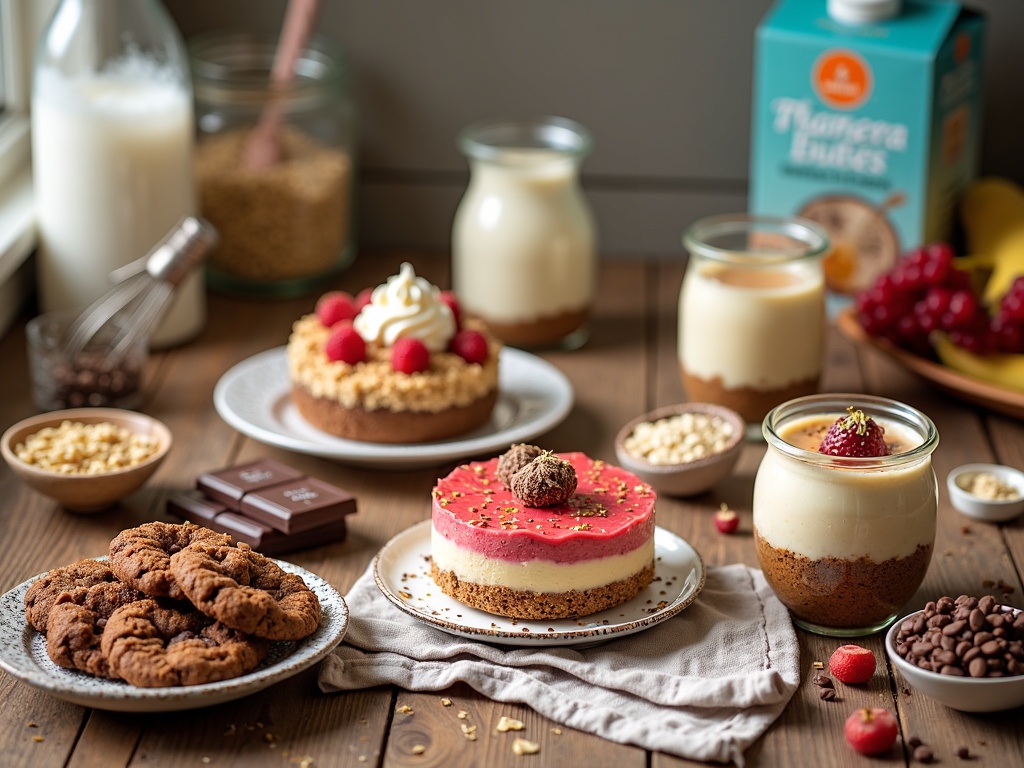
Pro Tips For Perfect Results
Mastering desserts requires attention to detail and a bit of know-how. I’ve gathered some essential tips to help you achieve bakery-quality results every time you make your favorite sweet treats.
Getting Your Basics Right
Temperature control makes or breaks most desserts. Room temperature eggs and butter blend more smoothly into batters, creating lighter textures in everything from chocolate crinkle cookies to fluffy cakes. I always set ingredients out at least an hour before baking.
Ingredient preparation deserves special attention too. Consider these key points:
- Measure flour by spooning it into measuring cups rather than scooping directly from the container to avoid compacting
- Sift dry ingredients when making delicate desserts like sticky toffee pudding for better incorporation
- Use high-quality vanilla extract instead of imitation for noticeably improved flavor
- Chill cookie dough for at least 30 minutes before baking for better shape retention
Timing techniques can significantly impact your results. I’ve found that rotating pans halfway through baking ensures even browning, especially important when making Biscoff cheesecake or similar desserts that need uniform cooking.
Next-Level Finishes
Decoration doesn’t need to be complicated. For beginners, I recommend starting with simple techniques like dusting powdered sugar over hot cocoa brownie squares or adding fresh berries to top a rhubarb crumble.
When things go wrong, stay calm and consider these common fixes:
- Soggy bottoms on pies or tarts? Blind bake the crust first with parchment paper and pie weights.
- Lumpy pudding texture? Strain it through a fine-mesh sieve before cooling.
- Runny custard? Cook it longer on low heat, stirring constantly.
- Cracked cheesecake? Add a water bath during baking to maintain humidity.
- Sinking center in cakes? Avoid opening the oven door during the first two-thirds of baking time.
For make-ahead options, most cookie doughs freeze beautifully for up to three months. Puddings like chia seed pudding can be prepared days in advance, with flavors actually improving as they rest.
By focusing on these details, you’ll transform your dessert game from hit-or-miss to consistently impressive. The joy on people’s faces when you serve them something homemade and perfect is absolutely worth the extra care.
Seasonal Dessert Recommendations
Summer calls for light, refreshing desserts that help beat the heat while satisfying sweet cravings. I’ve found frozen treats like homemade ice cream, sorbets, and popsicles to be perfect for hot days. Fresh berry parfaits layered with Greek yogurt offer a healthier option that doesn’t sacrifice flavor. For dinner parties, consider a chilled lemon mousse or a no-bake Biscoff cheesecake that won’t require heating up your kitchen.
When fall arrives with its cooler temperatures and harvest bounty, it’s time for heartier desserts featuring seasonal fruits and warm spices. Apple crumbles, pear tarts, and pumpkin-spiced everything dominate autumn menus for good reason. I particularly love making caramel apple upside-down cake and maple pecan pie during this season. The combination of cinnamon, nutmeg, and cloves creates that quintessential fall flavor profile that’s so comforting as temperatures drop. A rhubarb crumble with a touch of ginger makes for a fantastic transition dessert between summer and fall.
Winter Comfort Desserts
Winter desserts center around warmth and comfort. During the coldest months, I gravitate toward these cozy treats:
- Rich chocolate desserts like flourless chocolate cake or hot cocoa topped with homemade marshmallows
- Classic bread pudding made with leftover panettone or brioche
- Warm apple or pear crisps served with vanilla ice cream for temperature contrast
- Sticky toffee pudding with butterscotch sauce for special occasions
- Spiced gingerbread with lemon glaze
The holidays also bring opportunity for show-stopping desserts like bûche de Noël (yule log cake), cranberry-orange trifle, and decorated sugar cookies. These special treats create tradition and memorable moments around the table.
As winter fades into spring, I start incorporating fresher flavors and lighter textures. Spring desserts celebrate new beginnings with bright citrus notes, fresh berries, and delicate herbal infusions. Lemon bars, strawberry shortcake, and rhubarb pies all showcase the season’s bounty. I love making lavender-infused shortbread cookies and honey-yogurt panna cotta with fresh berries for springtime gatherings.
For Easter and other spring celebrations, carrot cake with cream cheese frosting connects beautifully to seasonal themes. Chia pudding topped with the first strawberries of the season makes for a delightful breakfast-dessert crossover.
Key lime pie offers a perfect transition into early summer, while still feeling light enough for spring. For something a bit different, try orange blossom water to flavor custards or infuse syrups for pound cakes.
Regardless of season, chocolate lovers needn’t worry — there’s always room for chocolate! Crinkle cookies work year-round but can be adapted seasonally:
- Add peppermint during winter
- Orange zest in spring
- Espresso powder in fall
- A touch of sea salt for summer
The beauty of seasonal desserts lies in their connection to nature’s rhythms. By following what’s fresh and available, desserts taste better and feel more special. I’ve found that anticipating particular treats at specific times of year creates traditions and memories that enhance enjoyment beyond just flavor.
Whether you’re an experienced baker or just starting out, trying desserts that align with the season provides inspiration and keeps your sweet offerings fresh and exciting throughout the year. Seasonal ingredients at peak freshness simply taste better, and building your dessert repertoire around these natural cycles connects you to culinary traditions that have evolved over generations.

